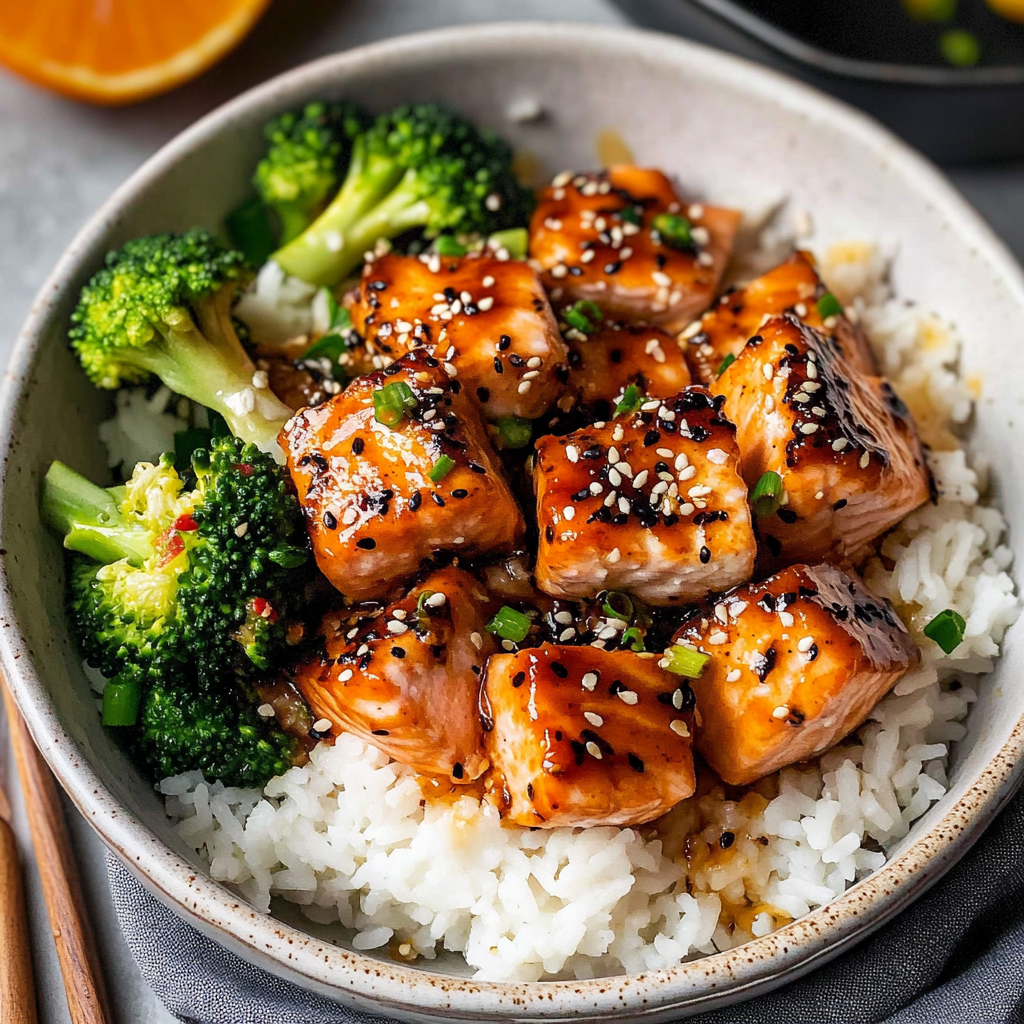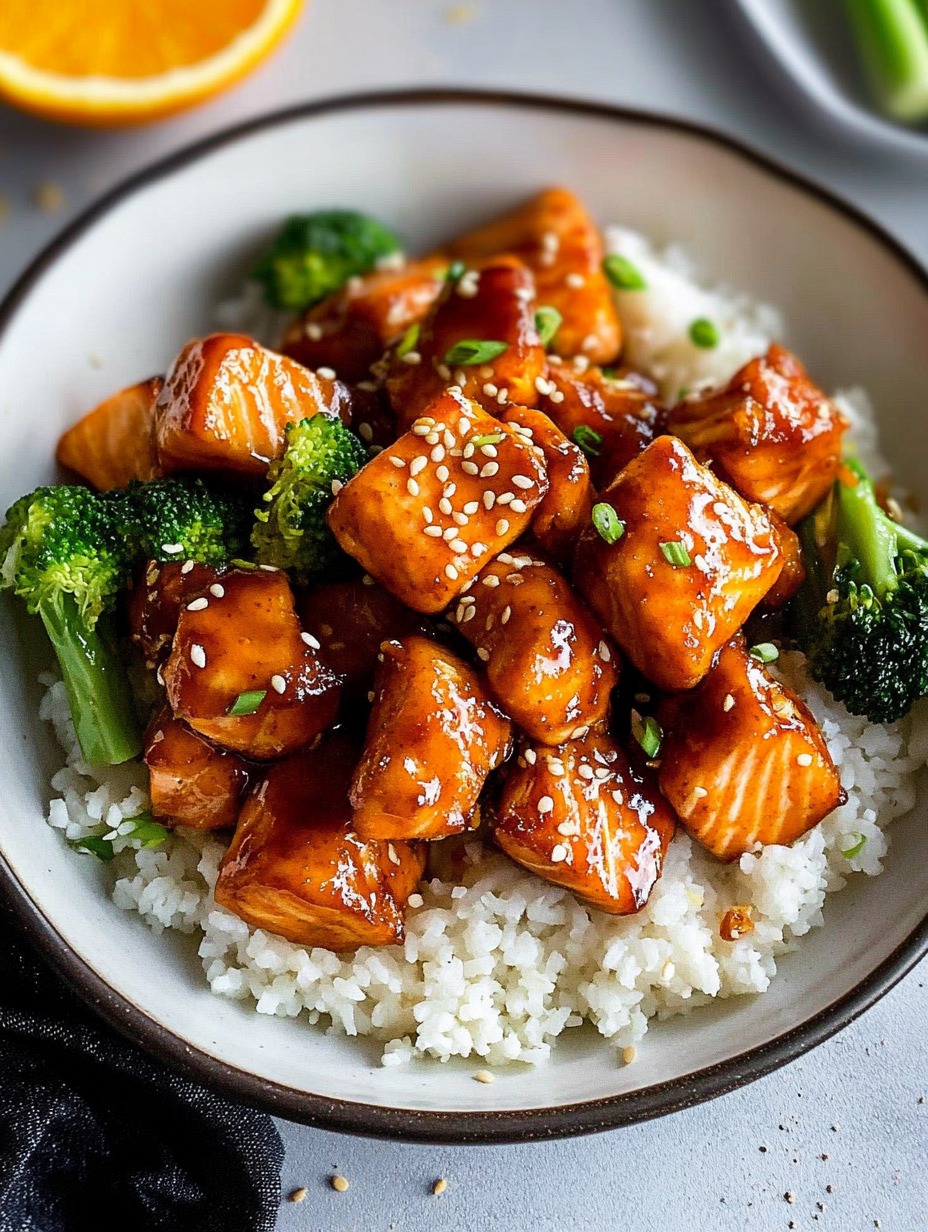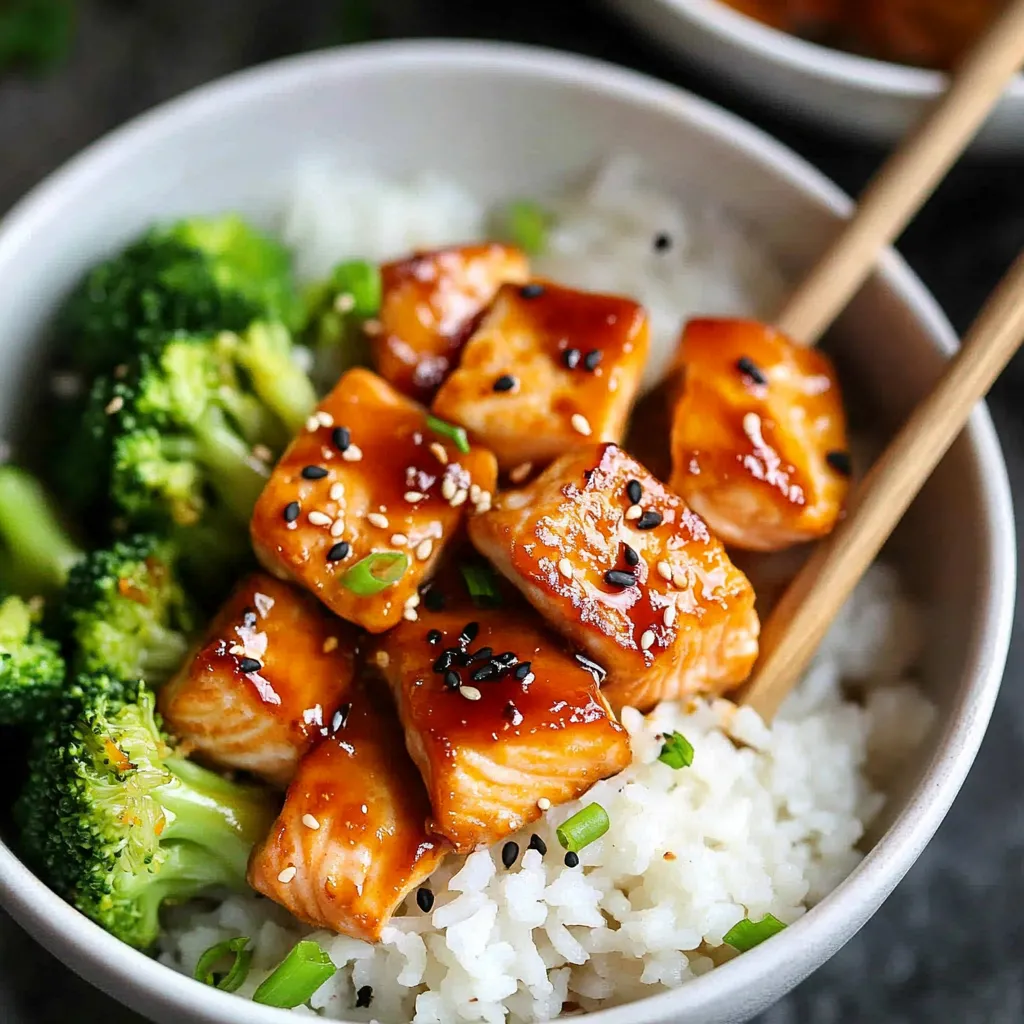 Pin it
Pin it
The tantalizing aroma of zesty orange combined with perfectly cooked salmon creates a mouthwatering experience that transforms an ordinary weeknight dinner into something exceptional. Crispy Orange Salmon Bowls deliver restaurant-quality flavor with minimal effort, coming together in just 30 minutes from start to finish. The combination of tender salmon cubes coated in a sticky-sweet orange glaze nestled alongside vibrant vegetables and fluffy rice creates a balanced meal that satisfies both the eyes and the palate.
I discovered this recipe during a particularly hectic week when I needed nutritious meals that wouldn't keep me chained to the kitchen. After making it three nights in a row, I was still enchanted by how the bright citrus notes complemented the rich salmon. My husband, typically indifferent to seafood, actually requested seconds and has since added it to our regular rotation.
Ingredients You'll Need
- 1 pound fresh salmon – Look for wild-caught when possible for superior flavor and nutritional benefits; ask your fishmonger to remove the skin or leave it on for extra crispiness
- Fresh orange juice and zest – Always use fresh-squeezed rather than bottled for that vibrant citrus punch; Meyer oranges offer a sweeter profile if available
- Soy sauce or tamari – Choose low-sodium options to better control the salt level; tamari provides a richer flavor while keeping the dish gluten-free
- Honey – Local raw honey adds complexity and supports sustainable beekeeping; adjust quantity to your sweetness preference
- Fresh ginger and garlic – These aromatic powerhouses should be freshly minced/grated for maximum impact; pre-minced versions lack the essential oils that make this dish sing
- Rice vinegar – Adds the perfect tangy balance to the sweetness; unseasoned works best to control additional flavors
- Red pepper flakes – Creates a gentle heat that enhances rather than overwhelms; Korean gochugaru offers a more complex spice profile if you have it
Step-by-Step Instructions
- Step 1:
- Prepare Your Marinade Base – In a medium-sized glass bowl, combine the freshly squeezed orange juice from two medium oranges with the zest of one orange, making sure to avoid the bitter white pith. Add three tablespoons of soy sauce or tamari, two tablespoons of honey, one tablespoon of rice vinegar, two cloves of minced garlic, one tablespoon of freshly grated ginger, and a half teaspoon of red pepper flakes. Whisk these ingredients together until the honey has completely dissolved into the mixture, creating a glossy, aromatic marinade with a beautiful amber color.
- Step 2:
- Prepare Your Salmon – Pat your salmon completely dry with paper towels to ensure proper browning later. Using a sharp knife, cut the salmon into uniform 1-inch cubes, ensuring even cooking throughout. If you've kept the skin on, make sure each cube has a piece of skin attached for that extra textural contrast when pan-fried. Place the salmon cubes into the prepared marinade, gently tossing to coat each piece thoroughly. Cover the bowl and allow the salmon to marinate for exactly 15 minutes—long enough to impart flavor but not so long that the acid in the orange juice begins to "cook" the fish.
- Step 3:
- Prepare Your Cooking Station – While the salmon marinates, set up your cooking area by measuring out one tablespoon of cornstarch and two tablespoons of cold water in a small bowl, but don't mix them yet. Have an additional tablespoon each of minced garlic and grated ginger ready beside your stove. Heat a large non-stick or well-seasoned cast iron skillet over medium heat and add two tablespoons of neutral oil with a high smoke point, such as avocado or grapeseed oil.
- Step 4:
- Create Your Aromatic Base – Add the prepared minced garlic and grated ginger to the heated oil, stirring constantly to prevent burning. Cook for approximately two minutes until fragrant and just beginning to turn golden at the edges. The aroma should be intoxicating but not acrid—if you smell burning, your heat is too high. This aromatic foundation will infuse the entire dish with depth and warmth.
- Step 5:
- Cook The Salmon To Perfection – Using tongs to avoid splashing, carefully transfer the marinated salmon cubes to the skillet, leaving the marinade behind in the bowl. Arrange the salmon pieces with space between them to ensure proper browning rather than steaming. Allow each side to cook undisturbed for 3-4 minutes before gently turning, creating a golden-brown crust that seals in the moisture. The salmon should be slightly undercooked in the center at this stage, as it will continue cooking with the sauce.
- Step 6:
- Transform The Marinade Into Glossy Sauce – While the salmon cooks, pour the reserved marinade into a small saucepan and bring it to a gentle simmer over medium-low heat. Whisk together the cornstarch and water to create a slurry, then slowly drizzle it into the simmering marinade while whisking constantly to prevent lumps. Continue cooking and whisking until the sauce thickens to a consistency that coats the back of a spoon, approximately 2-3 minutes. The transformation from thin marinade to glossy sauce is almost magical to watch.
- Step 7:
- Marry The Salmon With The Sauce – Once the salmon is golden on all sides and nearly cooked through, reduce the heat to low and pour about three-quarters of the thickened sauce directly over the salmon in the skillet. Gently toss to coat each piece evenly, allowing the sauce to bubble and further reduce for another 2-3 minutes. This creates the characteristic sticky glaze that defines this dish. For an extra dimension of texture, you can transfer the sauced salmon to a baking sheet and broil for 2-3 minutes until the edges caramelize and become irresistibly crispy.
- Step 8:
- Assemble Your Beautiful Bowls – Layer your serving bowls with fluffy steamed rice as the foundation, creating a bed to absorb the delicious sauce. Arrange your chosen vegetables—steamed broccoli florets, sautéed bell peppers, or crisp-tender carrots work beautifully—alongside the glazed salmon. Drizzle the remaining sauce over the entire bowl, ensuring every component receives some of that orange-infused goodness. Finish with a sprinkle of sesame seeds, sliced green onions, and a small wedge of fresh orange for both visual appeal and an extra burst of freshness when squeezed over the dish.
 Pin it
Pin it
My family has always been divided on seafood dishes, but this particular recipe bridged that gap beautifully. My daughter, normally hesitant about salmon, actually requested this for her birthday dinner last year. I've found that using blood oranges when in season creates a stunning ruby-tinged sauce that makes the presentation even more impressive for special occasions.
The Beauty of Bowl Meals
Bowl meals have revolutionized my approach to weeknight cooking. The layered presentation not only creates a visually appealing dish but allows each family member to customize their portion according to their preferences. My husband prefers extra spice, so I leave additional red pepper flakes on the table. My children enjoy separating components, while I love mixing everything together to get the perfect bite each time. These salmon bowls specifically inspired me to explore more international flavors in our regular meal rotation.
Perfect Pairings
While rice provides the traditional foundation for these bowls, experimenting with different bases elevates the experience significantly. Nutty quinoa adds protein and a pleasant textural contrast, while cauliflower rice keeps the meal lighter and lower in carbohydrates. For a more substantial offering during colder months, try serving over roasted sweet potato chunks, which complement the orange flavors beautifully and add another nutritional dimension to the meal.
Meal Prep Magic
These orange salmon bowls excel as a make-ahead option for busy professionals. Prepare all components separately—the sauce, the cooked salmon, the rice, and vegetables—and store in individual containers. Throughout the week, assemble bowls as needed, gently reheating components separately to maintain their distinct textures. The sauce actually improves after a day in the refrigerator as the flavors meld and intensify, making this an excellent option for planned leftovers.
 Pin it
Pin it
Nutritional Powerhouse
Beyond its incredible flavor profile, this meal provides exceptional nutritional benefits. The combination of omega-3 fatty acids from salmon, complex carbohydrates from rice, and fiber from vegetables creates a perfectly balanced plate. The vitamin C from the orange juice not only adds brightness but also enhances iron absorption from the vegetables, demonstrating how thoughtfully paired ingredients can work synergistically to improve overall nutrition.
My journey with this orange salmon recipe began during a particularly challenging period when I was seeking comfort food that wouldn't compromise my health goals. The bright citrus notes reminded me of childhood summers spent in Florida, where my grandmother would incorporate fresh oranges into nearly everything. There's something deeply satisfying about continuing that tradition through recipes like this one, creating new memories while honoring those flavor connections from the past. Whether you're cooking for one or feeding a family, these crispy orange salmon bowls bring vibrant color, nutrition, and joy to the table with minimal fuss—exactly what modern cooking should be.
Frequently Asked Questions
- → Can I use frozen salmon for this recipe?
- Yes, just make sure to thaw it completely and pat it dry with paper towels before marinating to ensure you get a good sear when cooking.
- → Can I substitute the orange juice with another citrus?
- Absolutely! While orange gives the classic flavor, you could use blood orange for a deeper flavor, or try a combination of lemon and lime juice for a different citrus profile.
- → Is there a substitute for cornstarch to thicken the sauce?
- Yes, you can use arrowroot powder or tapioca starch as a 1:1 replacement if you want to keep it paleo. All-purpose flour can also work but use 2 tablespoons instead of 1.
- → What other vegetables would work well with this dish?
- This salmon pairs beautifully with many vegetables! Try snap peas, asparagus, bok choy, bell peppers, or a mix of stir-fried vegetables for variety.
- → Can I make this dish ahead of time?
- While it's best fresh, you can prepare the sauce and marinate the salmon ahead of time. For meal prep, store the cooked salmon, rice, and vegetables separately and reheat gently to avoid overcooking the salmon.
